How to Sustainably Deep Clean Your House: A Room by Room Guide

Failing to proactively clean certain areas of your home — like ovens, baseboards, bathroom floors, and more — can lead to serious consequences. But cleaning with toxic chemicals and non-biodegradable materials can lead to even greater consequences for our planet.
Our guide will help teach you how to sustainably deep clean your house, how often, and easy DIY hacks to make your own green cleaners. Keeping these areas clean will contribute to the total wellness of your home, keep it looking great, and help you create a sustainable, eco-friendly cleaning routine to prevent issues before they can happen — for both your home and the environment.
Key takeaways:
- Sustainable cleaning means choosing eco-friendly products and practicing cleaning methods that do not negatively impact the environment.
- Proactively cleaning your home helps prevent serious issues before they occur.
- You can create several sustainable deep clean solutions easily from supplies you already have in your home.
- Proactive cleaning can help you crush homeownership.
How to sustainably deep clean your home

It’s no surprise that your home is made up of areas and appliances that need to be cleaned regularly. But did you know that you can do it yourself with household items you may not even know are sustainable? Follow these tips, tricks, and hacks on how to deep clean your house without harsh cleaners or products that create unnecessary waste to keep your home and environment happy.
Oven
Cleaning your oven doesn’t have to be the daunting, anxiety-ridden task that you’re accustomed to. This eco-friendly hack minimizes a lot of the elbow grease to make cleaning your oven less of a chore, while being less toxic and most likely cheaper too.
How to clean your oven racks
- Fill your bathtub with enough hot water to cover your oven racks.
- Add 1 ½ cups of natural dish soap and 5-7 eco-friendly dryer sheets.
- Swirl it around to make it bubbly.
- Submerge the racks in the water and let soak overnight.
- The next day, wipe the softened grit from the racks with another dryer sheet.
- Don’t forget to rinse your tub.
How to clean the inside of the oven
- Wet the inside of your oven with an eco-friendly sponge and water.
- Mix ½ cup of baking soda, ½ cup of salt, and ½ cup of water into a spreadable paste.
- Spread it around the inside of the oven, avoiding vents and heating elements.
- Leave it overnight.
- Wipe it clean.
Why be proactive? A dirty oven can release toxic smoke, and built-up grease and oil can cause damage to your heating elements or — even worse — become a fire hazard.
How often should you deep clean? Every three months
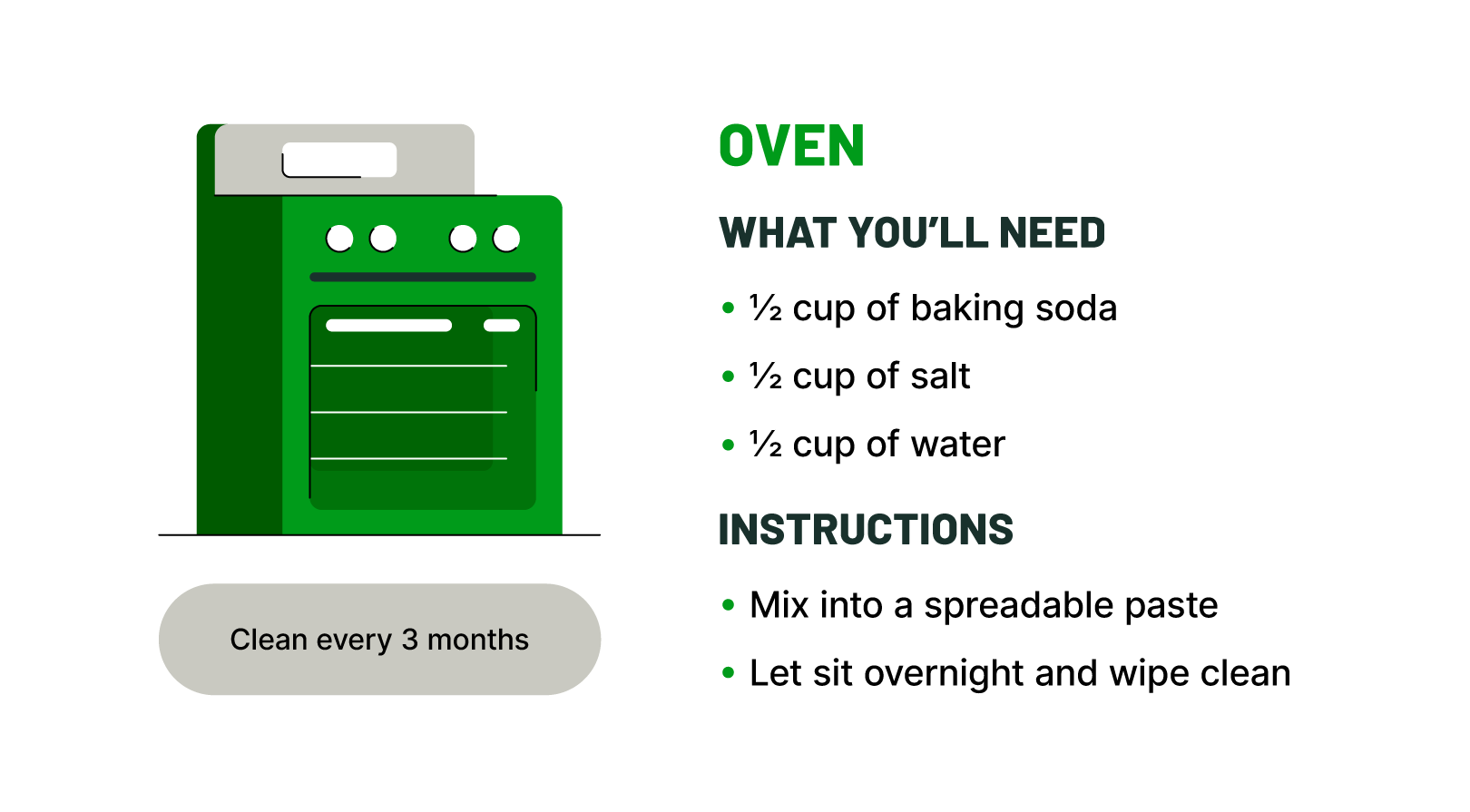
Kitchen and bathroom floors
Your kitchen and bathroom floors already have a rough life from getting walked on every day. Be kind to them by using natural, eco-friendly floor cleaners instead of harsh chemicals. Not only do toxic chemicals typically contain phthalates that have been linked to significant health dangers, but they also pollute waterways and leave landfills packed with wasteful packaging. Instead, try this baking soda and water mixture that is safe to use on all types of flooring.
- Mix 1 cup of baking soda and a squeeze of fresh lemon into a gallon of hot water.
- Mop as usual.
Why be proactive? Accumulated debris can cause damage to the floor or injury to people. Spills or food that falls on the floor, especially behind the stove and other hard-to-reach places, can attract destructive, unwanted pests.
How often should you deep clean? Weekly
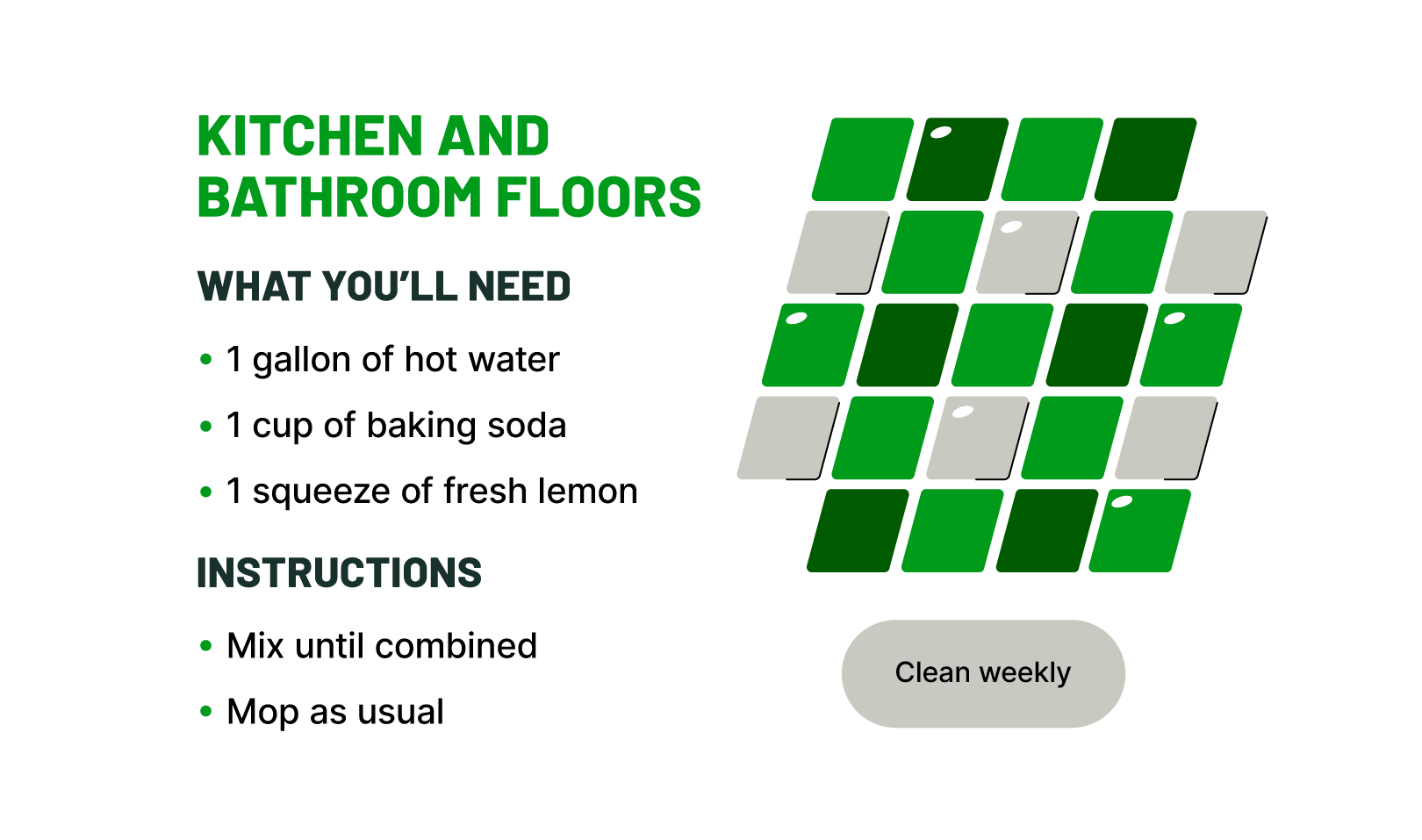
Countertops and baseboards
Making a game of dusting your countertops and baseboards with your kids can be a great way to stay on top of dusting. Games like dust racing can help turn a chore into a fun, family activity. After dusting, use sustainable solutions to safely keep away germs and chemicals from these areas often frequented by kids and pets.
- Mix a few drops of eco-friendly dish soap into 2 cups of water.
- Wipe with an organic cotton or bamboo towel.
Why be proactive? Spills or food left in hard-to-reach areas can cause stains to occur as well as harmful bacteria growth. Using sustainable cleaning solutions can also prevent damage from corrosive or acidic chemicals.
How often should you deep clean? Countertops daily, baseboards every two weeks
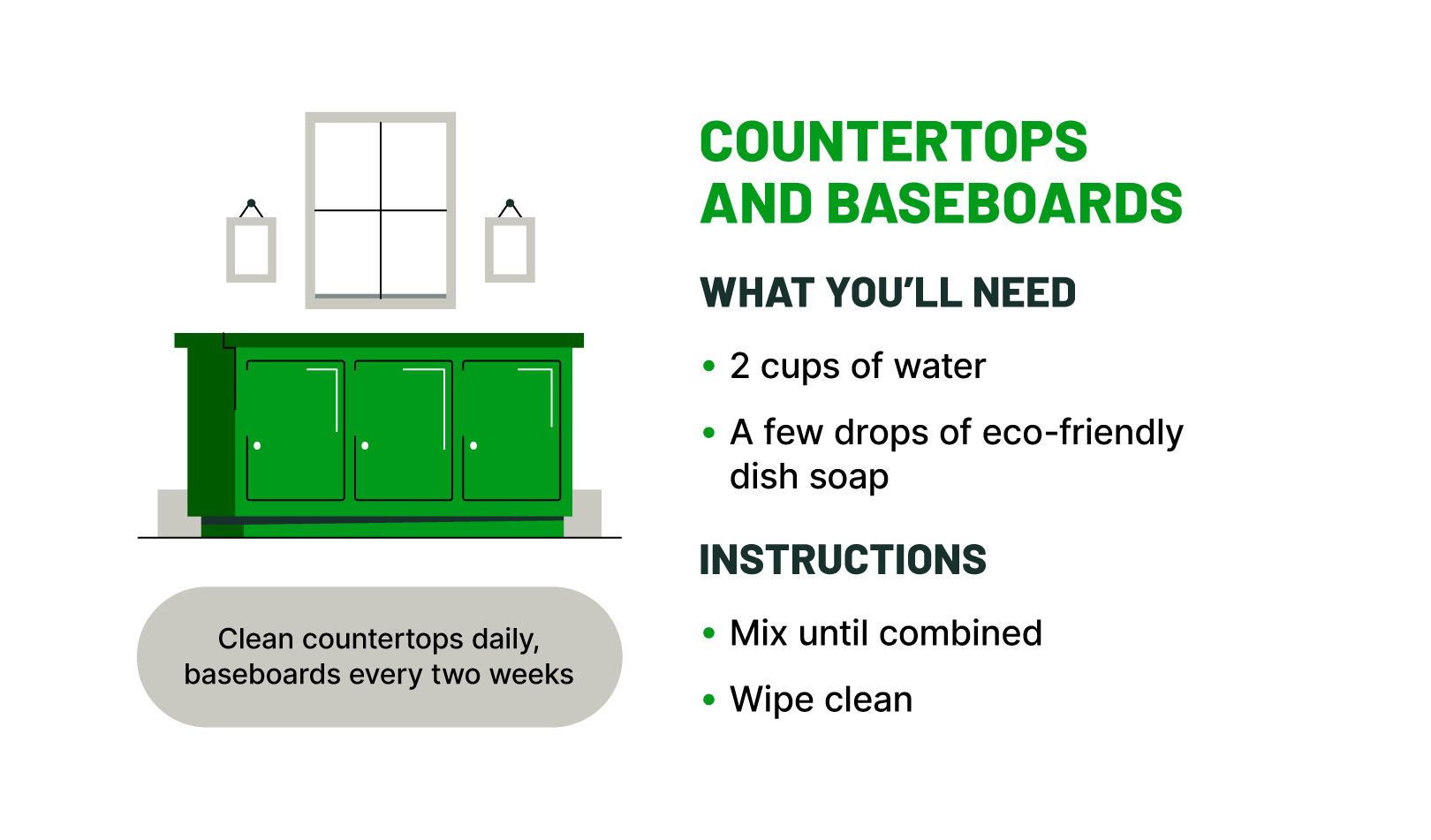
Refrigerator
Your refrigerator takes care of you and your family, so why not take care of your refrigerator with a bit of sustainable TLC? A clean refrigerator keeps food fresher and unsavory smells at bay. Up your green cleaning game with this sustainable cleaning recipe.
- Mix 1 part baking soda and 7 parts hot water.
- Remove the refrigerator shelves and hand wash them individually.
- Use the deep clean solution to wipe down the inside of your refrigerator.
- Use a sponge or even a toothbrush to clean debris from tight areas or corners.
- Wipe dry with an organic cotton cloth.
Why be proactive? Deep cleaning your fridge can prevent mold from growing and contaminating your food.
How often should you deep clean? Every three to four months
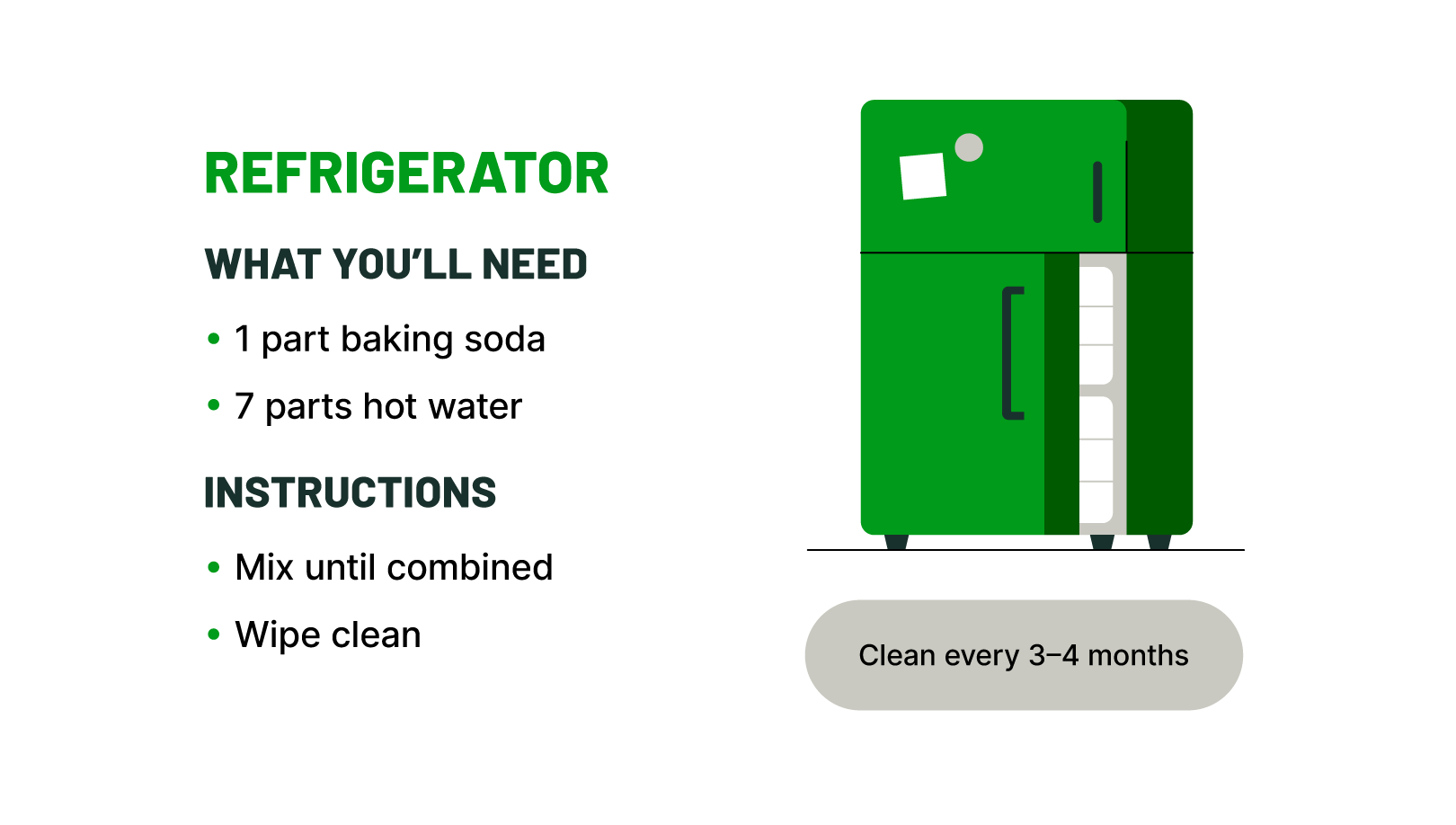
Windows and mirrors
It’s easy to see yourself cleaning your mirrors around the house (get it?), but windows — not so much. Keep your streak-free cleaning streak alive with this simple glass and mirror hack.
- Mix ½ cup of white vinegar and ½ cup of water in a reusable spray bottle.
- Spray surfaces and wipe with a reusable cloth or black and white newspaper for a streak-free shine.
Why be proactive? Windows that are not cleaned regularly have a higher risk of weakened glass and irreparable damage. This can include discoloration, cracking, or dry and damaged seals.
How often should you deep clean? Windows every three months, mirrors weekly.
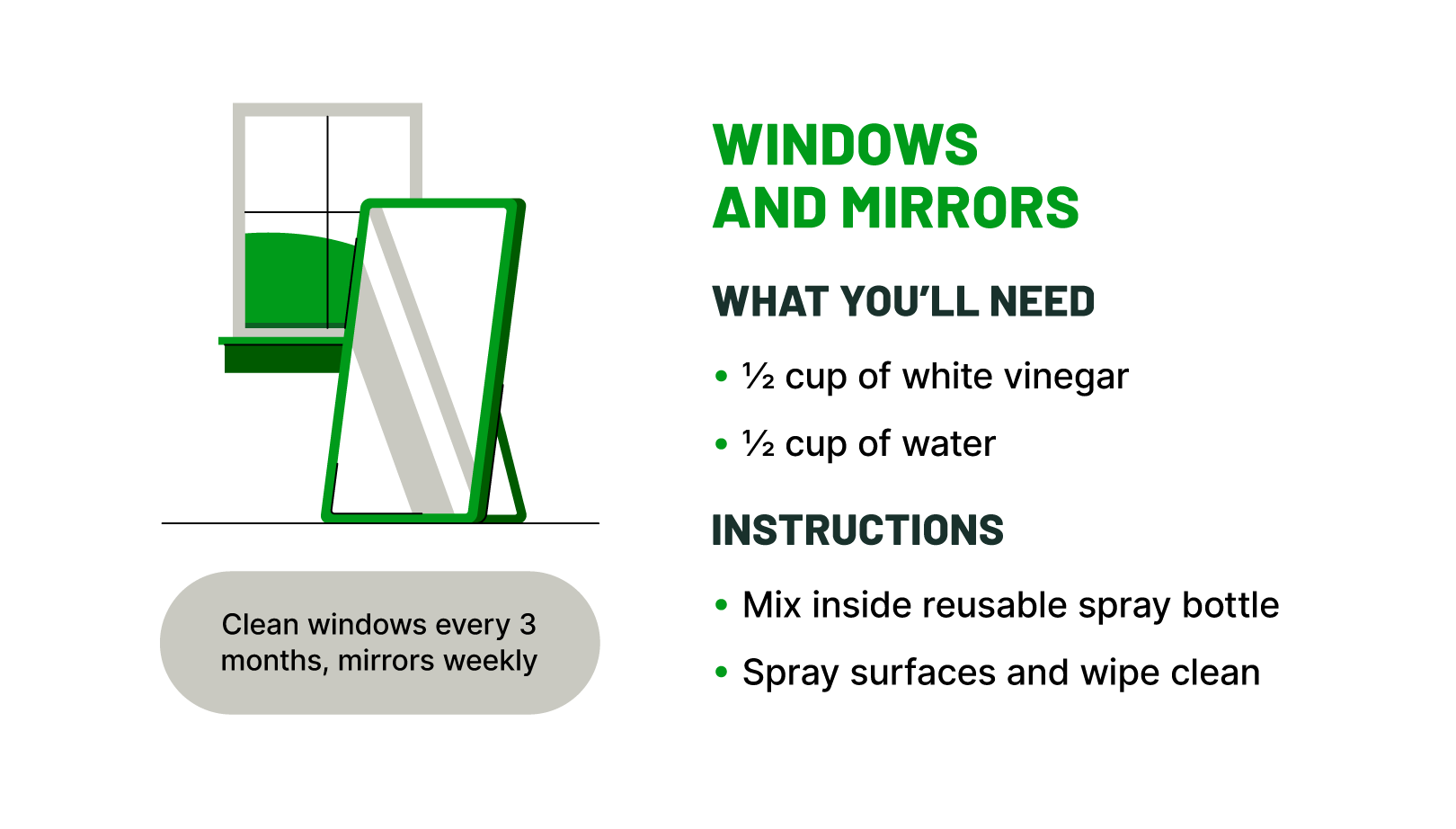
Garbage disposal
What’s that foul odor coming from the kitchen? Your garbage disposal may be a likely suspect. Before you reach for bleach or harsh drain cleaners, think again. Harsh chemicals can cause damage to the blades and pipes. Sustainable cleaning options are better for you and your garbage disposal.
- Unplug your garbage disposal. Safety first!
- Pull out the splash guard and scrub it with dish soap and a compostable sponge.
- Pour ½ cup baking soda and 1 cup of white vinegar into the disposal.
- Let it foam up and sit for a few minutes, then rinse with hot water.
- Reconnect the power and replace the splash guard.
- Pour 2 cups of ice and 1 cup of salt into the disposal.
- Turn on the cold water and run the disposal until the ice has been completely ground up. The ice and salt make for an effective blade scrubber.
- Run the empty half of a used lemon or a handful of citrus peels through the disposal (with water) to eliminate odors.
Why be proactive? Starchy foods like pasta, rice, and potatoes swell with water and can clog your drain. Always run water while running your garbage disposal and be mindful about what you’re putting into it.
How often should you deep clean? Every two weeks
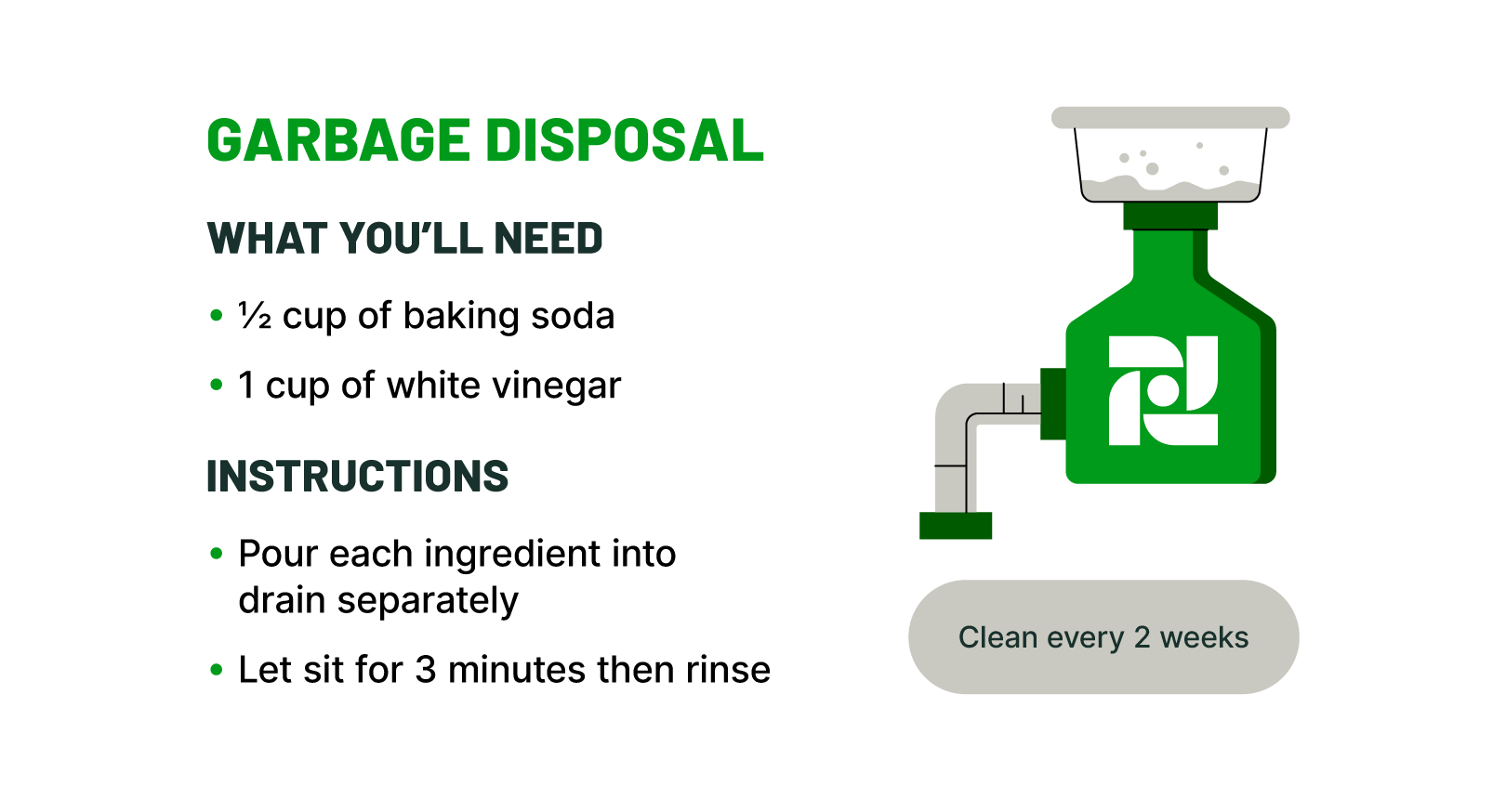
Microwave
Somebody didn’t cover their bowl of spaghetti and now the inside of your microwave looks like a scene from a horror movie. Dried food stuck to the walls of your microwave can feel like it’s never coming off. This microwave cleaning hack just may change your life.
- Squeeze 1 whole organic lemon into a small, microwave-safe bowl filled with water, then toss in the lemon itself.
- Microwave the bowl for 3-5 minutes on high (or until boiling).
- The steam will loosen the food stuck on the microwave’s walls and ceiling while the lemon will neutralize any bad odors.
- Allow the bowl to cool off then remove it.
- Wipe down the inside with an organic cotton cloth.
Why be proactive? Food particles built up inside your microwave not only waste energy but also make your microwave work harder. Over time, the stress from the extra energy can cause the microwave to malfunction or break down.
How often should you deep clean? Weekly or as needed
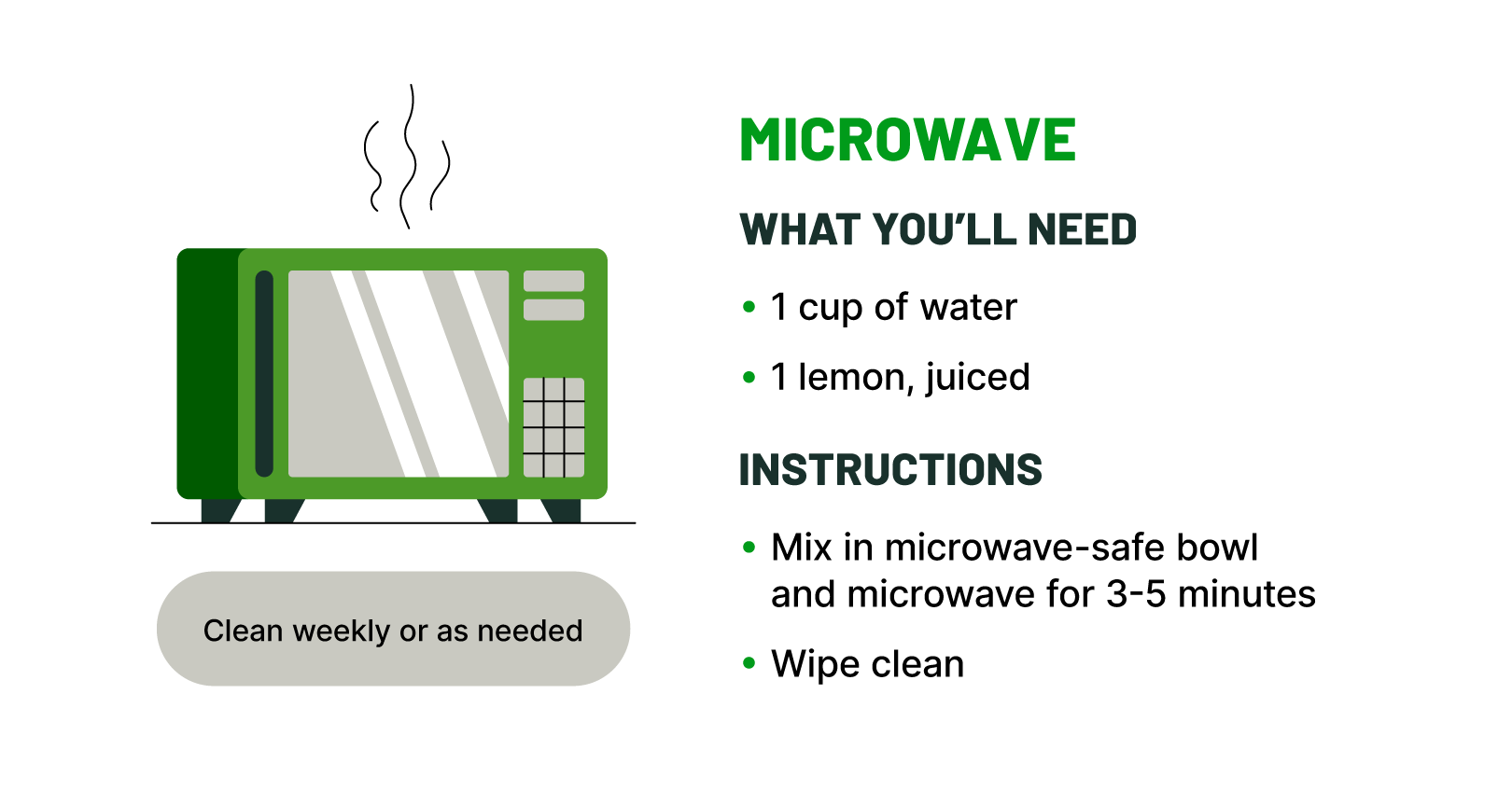
Toilet
Sitting on the throne as the least enjoyable area to deep clean in your home is the toilet. In “loo” of using toxic chemicals to do your business of cleaning, there are much better sustainable options to benefit the environment.
- Mix 1 cup of water, ½ cup of baking soda, and ½ cup of castile soap into a spray bottle.
- Add a few drops of organic lemon juice to help eliminate odors.
- Spray inside of the bowl and let sit for a few minutes.
- Scrub with a toilet brush.
Why be proactive? Simply put, toilets are the most germ-covered areas in your home. Putting off cleaning your toilet may result in gnarly illnesses.
How often should you deep clean? Every few days to weekly, depending on family size
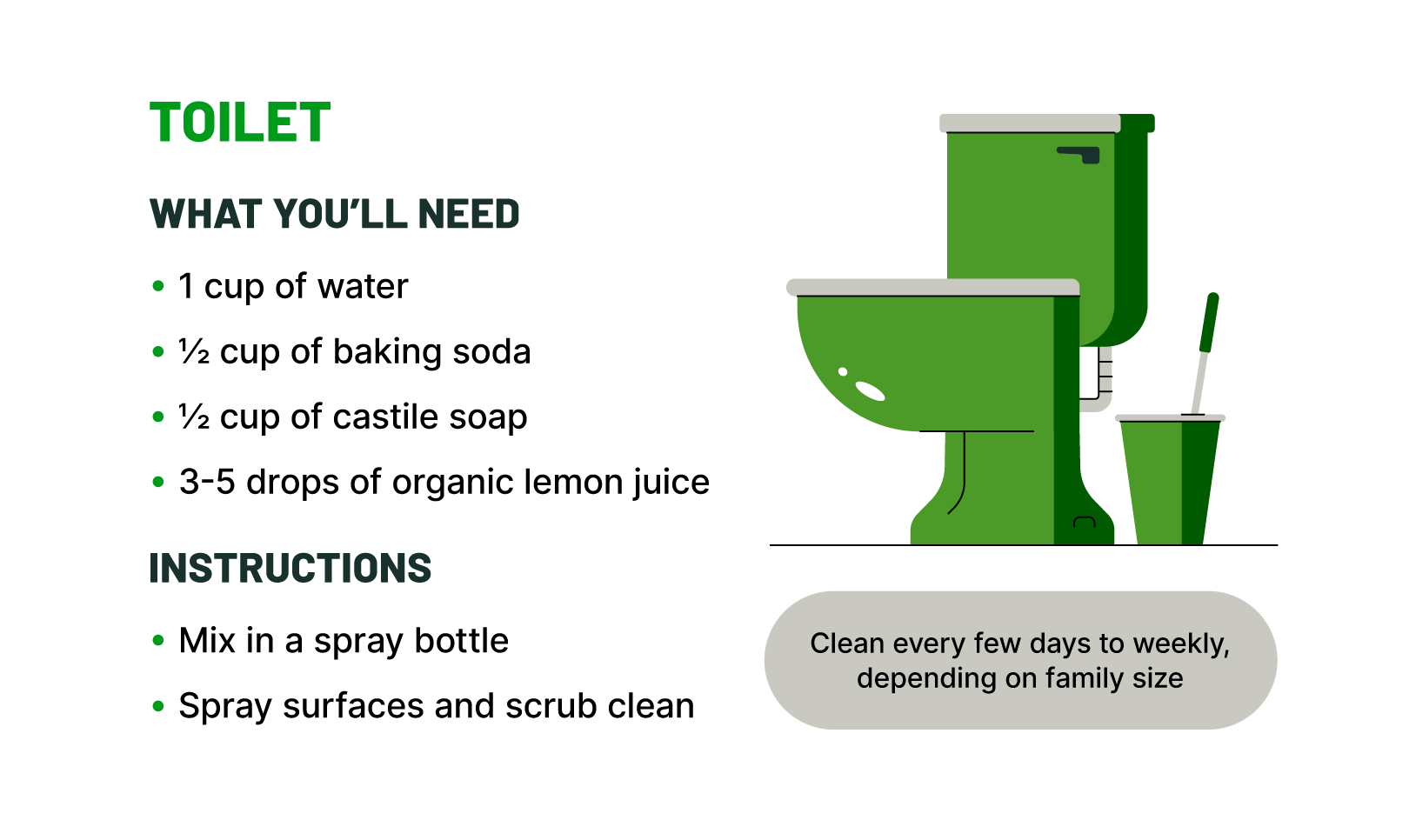
Air
It’s important to keep the air you breathe inside your home fresh, clean, and chemical-free. Traditional air fresheners contain chemicals while pollutants in the air can be harmful to your health. If you’ve been sniffing around for some sustainable ways to help keep your air pure, these tips smell like a winner.
- Use an essential oil diffuser.
- Invest in houseplants to help freshen the air (they also look great).
- Open your windows.
- Light organic candles made from plant-based wax with all-natural fragrances.
Why be proactive? Indoor air quality has a direct result on health issues, from allergens to extremely harmful gases. Monitoring your air with a smart home device like a carbon monoxide detector may even save your life.
How often should you deep clean? As needed
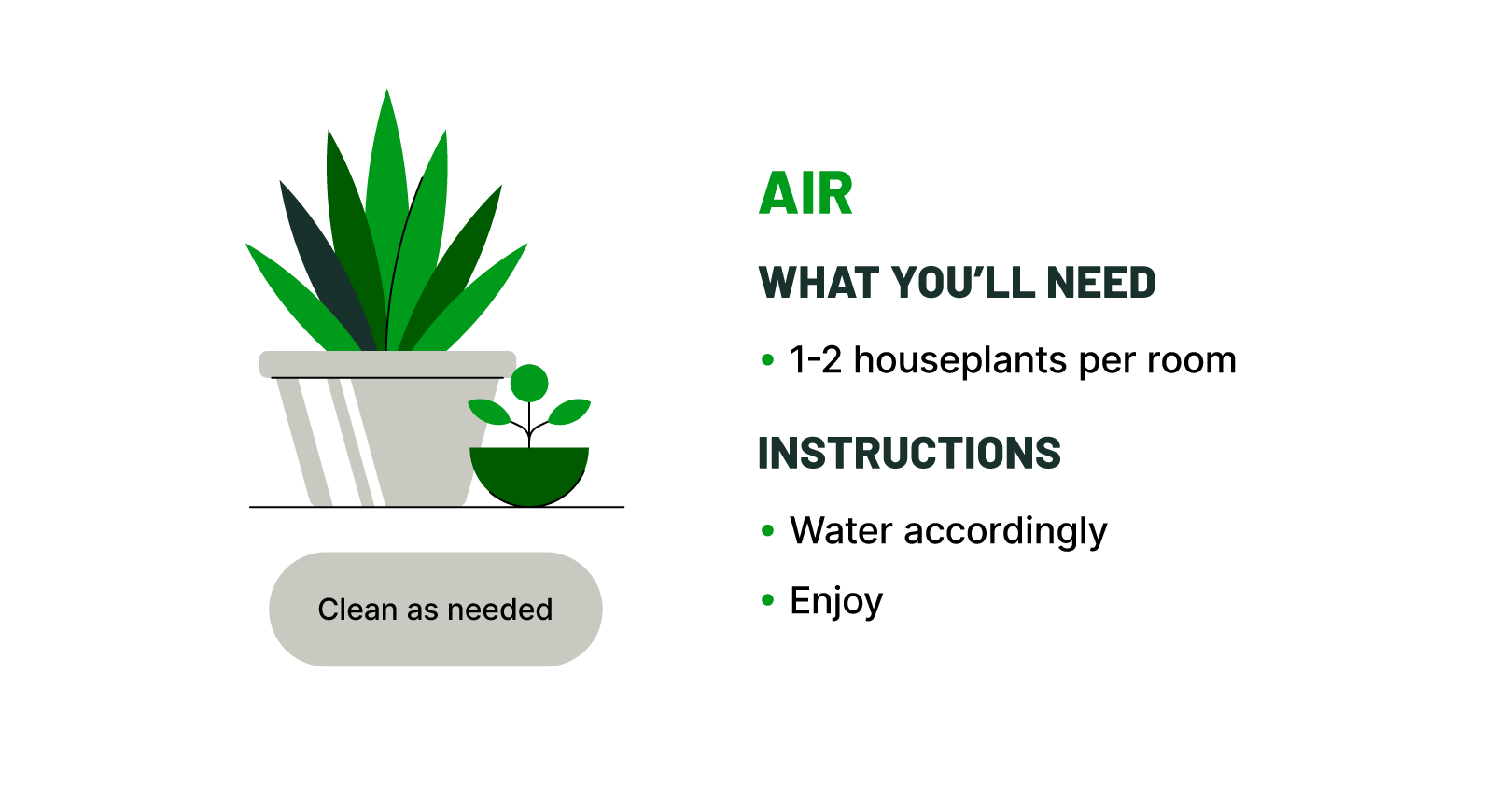
Sustainable cleaning tips
Sustainable cleaning is choosing eco-friendly products and practicing sustainable cleaning methods that do not negatively impact the environment. Follow these cleaning habits with the sustainable practices below.
Use sustainable cleaners
When choosing a cleaning product, try and make sure every aspect of the product is sustainable, optimally a zero-waste cleaner. That means the product inside the bottle doesn’t harm the environment, and the packaging is reusable, recyclable, or compostable. These tips can help make choosing a sustainable product easier.
- Look for non-toxic cleaners with recyclable or reusable packaging
- Make your own organic all-purpose cleaner and put it in reusable bottles (vinegar/water/lemon/rosemary)
- Pick natural cleaning products, including plant-based, organic cleaners, baking soda, vinegar, lemon, and essential oils
Ditch paper towels
Single-use paper towels have gone hand in hand with cleaning practices for decades. However, they contribute to landfill waste, deforestation, and global warming. Try these paper towel alternatives for sustainable cleaning.
- Choose reusable or washable organic cotton towels.
- Try compostable, multi-use bamboo towels to help with cleanups and spills.
Repurpose household items
An easy way to make an item sustainable is to repurpose it for something else, instead of throwing it in the trash. Here are some hacks to breathe new life into used items.
- Toothbrushes can be used for scrubbing awkward or hard-to-reach areas.
- Old newspapers can be used as a towel for lint- and streak-free glass cleaning.
- Coffee grounds when combined with a cleaning agent, can be repurposed as a scrubbing agent for countertops.
- Glass jars can be repurposed for storage or as drinking glasses.
Use compostable trash bags
Scrap traditional plastic bags and choose compostable trash bags instead. Most plant-based bags break down completely in 90 days and even add nutrients back into the soil. Traditional plastic bags can stay in a landfill for hundreds of years.
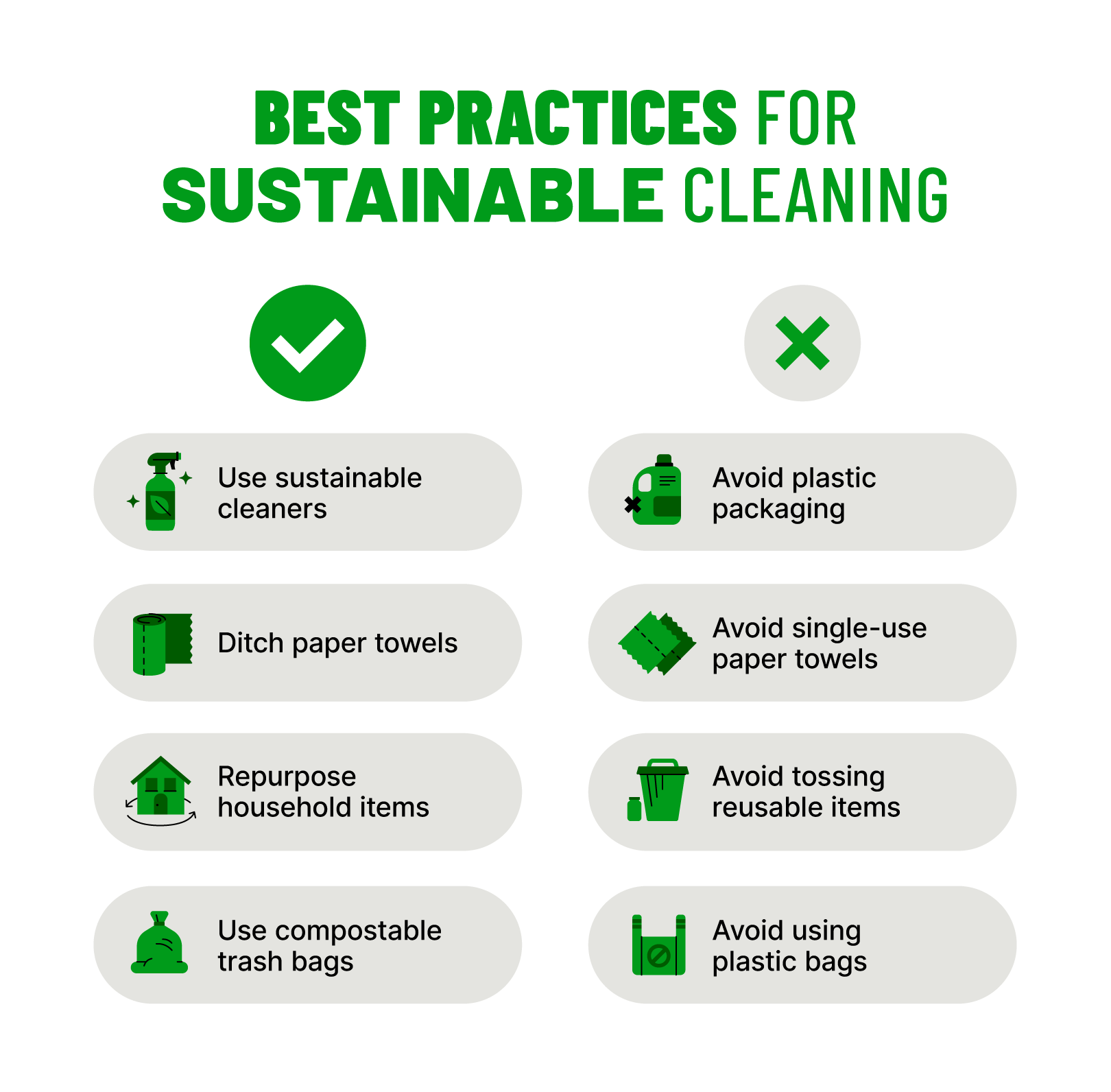
How proactive cleaning can help you crush homeownership
Proactively cleaning can prevent small things from becoming big problems. Keep a schedule to do a little bit at a time and use Hippo Home Care as proactive options for maintenance issues you may find along the way. Here are a few benefits of keeping your house squeaky clean:
- Eliminates germs
- Keeps pests away.
- Lowers stress.
- Removes allergens.
- Improves safety (slips, trips, and falls).
- Contributes to the total wellness of the home.
For extra tips and hacks, this page of helpful apps can further empower you to crush your cleaning and organization schedule.
Maintaining the cleaning of your home and performing simple, preventative maintenance proactively can help to ward off unnecessary issues or damages. Hippo is here with a modern take on homeowners insurance to help you protect your home so you’re prepared when the unexpected occurs. Get your quote in under 60 seconds to start crushing homeownership.

